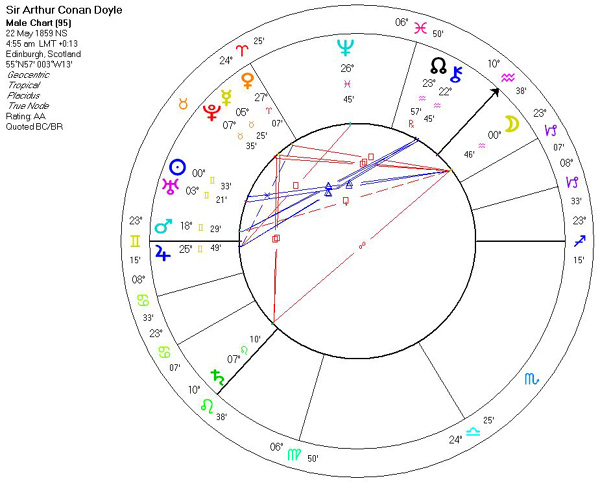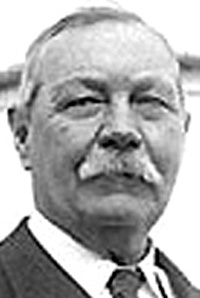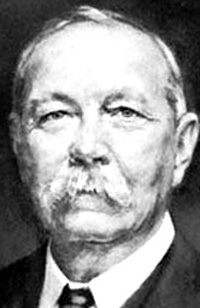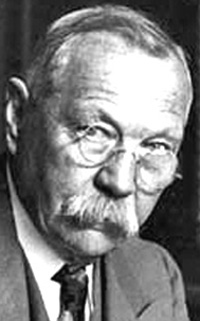Copyright Michael D. Robbins 2005
Astro-Rayological
Interpretation & Charts
Quotes
Biography
Images and Physiognomic Interpretation
Detection is, or ought to be, an exact science, and should be treated in the same cold and unemotional manner. You have attempted to tinge it with romanticism, which produces much the same effect as if you worked a love-story or an elopement into the fifth proposition of Euclid. Mars in Gemini conjunct Ascendant.
A man should keep his little brain attic stocked with all the furniture that he is likely to use, and the rest he can put away in the lumber room of his library, where he can get it if he wants it.
“I have usually found that there was method in his madness.”
“Some folk might say there was madness in his method.”We can’t command our love, but we can our actions.
It has long been an axiom of mine that the little things are infinitely the most important.
Our ideas must be as broad as Nature if they are to interpret Nature.
Gemini Sun.I have frequently gained my first real insight into the character of parents by studying their children.
Virgo on cusp of 5th house?Mediocrity knows nothing higher than itself, but talent instantly recognizes genius.
I have seen too much not to know that the impression of a woman may be more valuable than the conclusion of an analytical reasoner.
When you have eliminated the impossible, whatever remains, however improbable, must be the truth.
Venus in Aries.Life is infinitely stranger than anything which the mind of man could invent. We would not dare to conceive the things which are really merely commonplaces of existence. If we could fly out of that window hand in hand, hover over this great city, gently remove the roofs and peep in at the queer things which are going on, the strange coincidences, the planning, the cross-purposes, the wonderful chain of events, working through generations and leading to the most outre results, it would make all fiction with its conventionalities and foreseen conclusions most stale and unprofitable.
“The plot thickens,” he said, as I entered.
“What business is it of yours, then?”
“It’s every man’s business to see justice done.”
Libra on cusp of 6th house.It is a capital mistake to theorize before one has data.
The ideal reasoner,” he remarked, “would, when he had once been shown a single fact in all its bearings, deduce from it not only all the chain of events which led up to it but also all the results which would follow from it.
Mercury conjunct Pluto square Saturn.My mind rebels at stagnation. Give me problems, give me work, give me the most abstruse cryptogram, or the most intricate analysis, and I am in my own proper atmosphere. I can dispense then with artificial stimulants. But I abhor the dull routine of existence. I crave for mental exaltation.
Sun, Mars & Uranus in Gemini. Saturn in 3rd house.The most winning woman I ever knew was hanged for poisoning three little children for their insurance-money, and the most repellent man of my acquaintance is a philanthropist who has spent nearly a quarter of a million upon the London poor.
The most difficult crime to track is the one which is purposeless.
There is nothing more deceptive than an obvious fact.
Where there is no imagination there is no horror.
Neptune in Pisces.My name is Sherlock Holmes. It is my business to know what other people don't know.
You know my method, Watson. It is founded on the observances of trifles.
It is a great thing to start life with a small number of really good books which are your very own
Crime is common. Logic is rare. Therefore it is upon the logic rather than upon the crime you should dwell.
I never remember feeling tired by work, though idleness exhausts me completely.
Arthur Conan DoyleSir Arthur Ignatius Conan Doyle (May 22, 1859 – July 7, 1930) is the British author most famously known for his stories about the detective Sherlock Holmes, which are generally considered a major innovation in the field of crime fiction. He was a prolific writer whose other works include science fiction stories, historical novels, plays and romances, poetry, and non-fiction.
He is sometimes called Conan Doyle—Conan was originally a middle name but he used it as part of his surname in his later years.
Life
He was born in 1859 in Edinburgh to Irish parents who had emigrated to Scotland. He was sent to the Jesuit preparatory school Stonyhurst at the age of nine, and by the time he left the school in 1875 he rejected Christianity to become an agnostic. From 1876 to 1881 he studied medicine at Edinburgh University, including a period working in the town of Aston (now a district of Birmingham). Following his term at University he served as a ship's doctor on a voyage to the West African coast, and then in 1882 he set up a practice in Plymouth. He won his doctorate in 1885. His medical practice was unsuccessful; while waiting for patients he began writing stories. His first literary experience came in Chambers's Edinburgh Journal before he was 20.It was only after he subsequently moved his practice to Southsea that he began to indulge more extensively in literature. His first significant work was A Study in Scarlet which appeared in Beeton's Christmas Annual for 1887 and featured the first appearance of Sherlock Holmes who was modeled after Doyle's former University professor, Joseph Bell.
In 1885 he married Louise Hawkins, who suffered from tuberculosis and eventually died in 1906. He married Miss Jean Leckie in 1907, whom he had first met and fallen in love with in 1897 but had maintained a platonic relationship with out of loyalty to his first wife. Doyle had five children, two with his first wife (Mary and Kingsley), and three with his second wife (Jean, Denis, and Adrian).
In 1890 Doyle studied the eye in Vienna, and in 1891 moved to London to set up a practice as an oculist. This also gave him more time for writing, and in November 1891 he wrote to his mother: "I think of slaying Holmes... and winding him up for good and all. He takes my mind from better things." In December 1893 he did so, with Holmes and his arch-nemesis Professor Moriarty apparently plunging to their deaths together over a waterfall in the story "The Final Problem". Public outcry led him to bring the character back—Doyle returned to the story in "The Adventure of the Empty House", saying that only Moriarty had fallen, but, since Holmes had other dangerous enemies, he had arranged to be temporarily "dead" also. Holmes eventually appeared in 56 short stories and four of Doyle's novels (he has since appeared in many novels and stories by other authors, as well).
Following the Boer War in South Africa at the turn of the century and the condemnation from around the world over Britain's conduct, Doyle wrote a short pamphlet titled The War in South Africa: Its Cause and Conduct which was widely translated. Doyle believed that it was this pamphlet that resulted in his being knighted and appointed as Deputy-Lieutenant of Surrey in 1902. He also wrote the longer book The Great Boer War in 1900. During the early years of the twentieth century Sir Arthur twice ran for Parliament as a Liberal Unionist, once in Edinburgh and once in the Border Burghs, but although he received a respectable vote he was not elected. He did, however, become one of the first Honorary Members of the Ski Club of Great Britain.
Conan Doyle was involved even in the campaign for the reform of the Congo Free State, led by the journalist Edmund Dene Morel and the diplomat Roger Casement. He wrote The Crime of the Congo in 1909, a long pamphlet in which he denounced the horrors in Congo. He become acquainted with Morel and Casement, taking even inspiration by them for two of the main character of the novel The Lost World (1912). He broke with both, however, with the first world war, when Morel (who was rather left-wing) became one of the leaders of the pacifist movement and Casement betrayed England for his Irish nationalistic views. He, however, tried to save Casement from death penalty, arguing that he had been driven mad and was not responsible of his act.
Doyle also caused two cases to be reopened. The first case, in 1906, involved a shy half-British, half-Indian lawyer named George Edalji, who had allegedly penned threatening letters and mutilated animals. Police were dead set on Edalji's guilt, even though the mutilations continued even after their suspect was jailed. It was partially as a result of this case that the Court of Criminal Appeal was established in 1907, so not only did Conan Doyle help George Edalji, his work helped to establish a way to correct other miscarriages of justice. The second case—that of Oscar Slater, a German Jew and gambling-den operator convicted of bludgeoning an 82-year-old woman in 1908—excited Doyle's curiosity because of inconsistencies in the prosecution case and a general sense that Slater was framed. It is not known whether either enjoyed the same resolution as Holmes' clients.
In his later years, Doyle became involved with Spiritualism, to the extent that he wrote a Professor Challenger novel on the subject, The Land of Mist. One of the odder aspects of this period of his life was his book The Coming of the Fairies (1921): He was apparently totally convinced of the veracity of the Cottingley fairy photographs, which he reproduced in the book, together with theories about the nature and existence of fairies and spirits. His work on this topic was one of the reasons that one of his short story collections, The Adventures of Sherlock Holmes, was banned in the Soviet Union in 1929 under the pretense of occultism. However, later this ban was cancelled.
Doyle was friends for a time with the American magician Harry Houdini, a prominent opponent of the Spiritualist movement. Although Houdini insisted that Spiritualist mediums employed trickery (and consistently attempted to expose them as frauds), Doyle became convinced that Houdini himself possessed supernatural powers, a view expressed in Doyle's The Edge of the Unknown. Houdini was apparently unable to convince Doyle that the former's feats were simply magic tricks.
Arthur Conan Doyle is buried in the Church Yard at Minstead in the New Forest, Hampshire, England.
A statue has been erected in Sir Arthur Conan Doyle's honour. It may be seen at Crowborough Cross in Crowborough, East Sussex, England, where Sir Arthur lived for 23 years.
Arthur Conan Doyle was born to a family of Roman Catholics in Edinburgh, in 1859. His father, Charles, was a civil servant who suffered from epilepsy and alcoholism. He was educated in Jesuit schools and eventually lost his faith in Catholicism in favor of his Jesuit training. He would later use his friends and teachers from Stonyhurst College as inspiration for characters in his Holmes stories.
Doyle married Louise Hawkins in 1884 and then in 1885 he graduated as a doctor from Edinburgh University. After graduation Doyle practiced medicine and specialized in eye care in Hampshire. He remained there until 1891 when he became a full time writer. His first story, a Sherlock Holmes novel called A Study in Scarlet, had been published in 1887.
Doyle followed his first novel with The Sign of Four and then in 1891 The Adventures of Sherlock Holmes was incrementally published by the Strand Magazine. His works were met with public approval and he soon became quite popular, in fact he would eventually, in the 1920s, become one of the highest paid writers in the world. But the massive initial popularity had an affect on Doyle and by the end of 1891 he had sworn to end the series, which he thought he achieved by killing Sherlock Holmes in The Final Problem, which was published in December of 1893.
During the South African War (1899-1902) Doyle served as a physician in a field hospital, where he wrote The Great Boer War in which he defended the policy of his homeland. After the war, in 1902, Doyle returned to England and was knighted. He then took up the pen again for the revered detective and published The Hound of the Baskervilles, a prequel, in 1902. He then resurrected his dead logician in The Empty House and continued writing short stories about Holmes and Watson.
In 1906 Doyle ran for Parliament but failed to be elected, the next year his wife, long ill, died. Shortly after his wife's death Doyle remarried to Jean Leckie. Then, in WWI, his son died. This was a tragedy for Doyle and it affected him deeply. As a result he dedicated the rest of his life to spiritual causes. His last book, a collection of short stories known as The Casebook of Sherlock Holmes was published in 1927. Doyle died of heart disease on July 7, 1930.
British writer, creator Sherlock Holmes, the best-known detective in literature and the embodiment of sharp reasoning. Doyle himself was not a good example of rational personality: he believed in fairies and was interested in occultism. Sherlock Holmes stories have been translated into more than fifty languages, and made into plays, films, radio and television series, a musical comedy, a ballet, cartoons, comic books, and advertisement. By 1920 Doyle was one of the most highly paid writers in the world.
--'This is indeed a mystery,' I remarked. 'What do you imagine that it means?'
--'I have no data yet. It is a capital mistake to theorise before one has data. Insensibly one begins to twist facts to suit theories, instead of theories to suit facts...'
--(from 'A Scandal in Bohemia', 1891)Arthur Conan Doyle was born at Picardy Place, Edinburgh, as the son of Charles Altamont Doyle, a civil servant in the Edinburgh Office of Works, and Mary (Foley) Doyle. Both of Doyle's parents were Roman Catholics. To increase his income Charles Altamont painted, made book illustrations, and also worked as a sketch artist on criminal trials. Not long after arriving Edinburgh he started to drink, he suffered from epilepsy and was eventually institutionalized. Richard Doyle (1824-83), the uncle of A.C. Doyle and the son of the caricaturist John Doyle, was also an illustrator. He worked for Punch and illustrated chiefly fairy stories, including Ruskin's The King of the Golden River, W. Allingham's In Fairyland and some of Dickens's Christmas Books.
Doyle's mother, Mary, whom he called "the Ma'am," was interested in literature, and she encouraged his son to explore the world of books. Doyle's second wife, Jean, said: "My husband's mother was a very remarkable and highly cultured woman. She had a dominant personality, wrapped up on the most charming womanly exterior." At the age of fourteen Doyle had learned French so that he could read Jules Verne in the author's original language. Charles Altamot died in an asylum in 1893; in the same year Doyle decided to finish permanently the adventures of his master detective. Because of financial problems, Doyle's mother kept a boarding house. Dr. Tsukasa Kobayashi has alluded in an article, that she had a long affair with Bryan Charles Waller, a lodger and a student of pathology, who had a deep impact to Conan Doyle. He also supported young Arthur financially. Mary's last child was named Bryan Julia Doyle - perhaps referring to Waller's mother, who also was Julia.
Doyle was educated in Jesuit schools. During this period Doyle lost his belief in the Roman Catholic faith, but the training of the Jesuits influenced deeply his thought. Later he used his friends and teachers from Stonyhurst College as models for his characters in the Holmes stories, among them two boys named Moriarty. Doyle studied at Edinburgh University and in 1884 he married Louise Hawkins.
Doyle qualified as doctor in 1885. After graduation Doyle practiced medicine as an eye specialist at Southsea near Porsmouth in Hampshire until 1891 when he became a full time writer. His first story, an illustrated tale of a man and a tiger, Doyle had produced at the age of six. Doyle's first novel about Holmes, A STUDY IN SCARLET, was published in 1887 in Beeton's Christmas Annual. The story was written in three weeks in 1886. It introduced the detective and his Sancho Panza and Boswell, Dr. Watson, the narrator. Their major opponent, the evil genius Dr. Moriarty, became a kind of doppelgänger of the detective. Also the intrigues of the beautiful opera singer Irene Adler caused much trouble to Holmes.
The second Sherlock Holmes story, The Sign of the Four', was written for the Lippincott's Magazine. Doyle collected a colorful group of people together, among them Jonathan Small who has a wooden leg and a dwarf from Tonga islands. The Strand Magazine started to publish 'The Adventures of Sherlock Holmes' from July 1891. Holmes's address at Mrs. Hudson's house, 221B Baker Street, London, is perhaps the most famous London street in literature.
Already at the end of 1891, Doyle planned to abandon the series. "I have had such an overdose of [Holmes] that I feel towards him as I do toward pâté de foie gras, of which I once ate too much, so that the name of it gives me a sickly feeling to this day", he confessed. In 1893 Doyle devised his death in the 'Final Problem,' published in the Strand in the December issue. Holmes meets Moriarty at the fall of the Reichenbach in Switzerland and disappears. Watson finds a letter from Homes, stating "I have already explained to you, however, that my career had in any case reached its crisis, and that no possible conclusion to it could be more congenial to me than this."
Doyle's readers expressed their disappointment by wearing mourning bands and Strand lost 20,000 subscriptions. In THE HOUND OF BASKERVILLES (1902) Doyle narrated an early case of the dead detective. The ingenious murder weapon in the story is an animal. Because of public demand Doyle resurrected his popular character in 'The Empty House' (1903). "I moved my head to look at the cabinet behind me. When I turned again Sherlock Holmes was standing smiling at me across my study table. I rose to my feet, stared at him for some seconds in utter amazement, and then it appears that I must have fainted for the first and last time in my life." (from 'The Empty House')
In these following stories Holmes stopped using cocaine. Although Doyle's later works have been criticized, several of them, including 'The Three Garridebs,' 'The Adventure of the Illustrious Client,' and 'The Veiled Lodger,' are highly enjoyable. Sherlock Holmes short stories were collected in five books. The first appeared in 1892 under the title THE ADVENTURES OF SHERLOCK HOLMES. It was followed by THE MEMOIRS OF SHERLOCK HOLMES (1894), THE RETURN OF SHERLOCK HOLMES (1904), HIS LAST BOW (1917), and THE CASE-BOOK OF SHERLOCK HOLMES (1927).
During the South African war (1899-1902) Doyle served for a few months as senior physician at a field hospital, and wrote THE WAR IN SOUTH AFRICA, in which he defended England's policy. The same uncritical attitude toward the British empire marked his history of World War I, THE BRITISH CAMPAIGN IN FRANCE AND FLANDERS, 1928 (6 vols.). Doyle was knighted in 1902 and in 1900 and 1906 he also ran unsuccessfully for Parliament. Fourteen months after his long-invalided wife Louisa died, Conan Doyle married in 1907 his second wife, Jean Leckie. When his son Kingsley died from wounds incurred in World War I, the author dedicated himself in spiritualistic studies. An example of these is THE COMING OF FAIRIES (1922). But he had already showed interest in occult fantasy before publishing Holmes stories. In his early novel, THE MYSTERY OF CLOOMBER (1888), a retired general finds himself under assault by Indian magic.
Doyle supported the existence of "little people" and spent more than a million dollars on their cause. The so-called "fairy photographs" caused an international sensation when Doyle published a favorable account of them in 1920. The photographs showed fairies dancing in the air. A year after, the Star newspaper reported that the fairies were from a poster. Doyle became president of several important spiritualist organizations. In 1925 he opened the Psychic Bookshop in London. Among his friends was the legendary American magician and escape artist Harry Houdini (1874-1926). He believed that Houdini possessed supernatural powers, which the magician himself denied. Another friend was D.D. Home. According to Doyle, he could levitate. Once Doyle claimed that Home "floated out of the bedroom and into the sitting room window, passing seventy feet above the street." His own psychic experiences Doyle recorded in THE EDGE OF UNKNOWN (1930), which was his last book. Doyle died on July 7, 1930 from heart disease at his home, Windlesham, Sussex.
"My contention is that Sherlock Holmes is literature on a humble but not ignoble level, whereas the mystery writers most in vogue now are not. The old stories are literature, not because of the conjuring tricks and the puzzles, not because of the lively melodrama, which they have in common with many other detective stories, but the virtue of imagination and style. They are fairy-tales, as Conan Doyle intimated in his preface to his last collection, and they are among the most amusing of fairy-tales and not among the least distinguished." (Edmund Wilson in Classics and Commercials, 1950)



